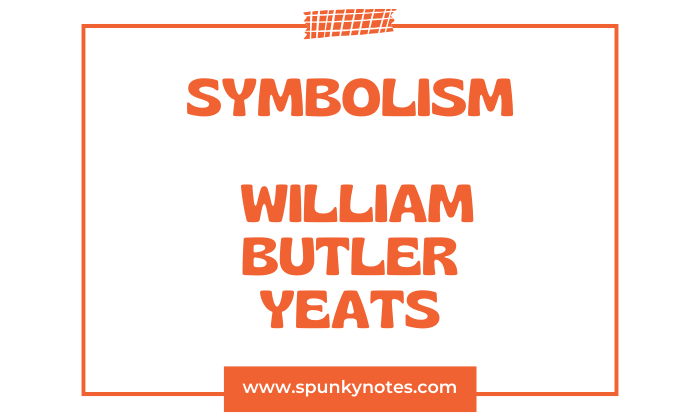
Q. How does William Butler Yeats use symbolism in his poetry to convey emotions?
Symbolism
Symbolism in literature uses symbols like objects, colours, or characters to suggest deeper meanings beyond their literal sense. This technique allows authors to convey emotions subtly to the readers.
Symbols in literature are not confined to their direct, literal meanings. They go beyond the obvious to suggest deeper, more abstract ideas. Using symbols, authors can express complex, difficult-to-conform thoughts and emotions with straightforward language.
For instance, a storm might represent not just the weather but also the turmoil in someone’s life. Symbols can have multiple interpretations based on their context within a story and the reader’s perspective, which allows for a more engaging and thought-provoking reading experience.
Symbolism in William Butler Yeats
William Butler Yeats was significantly influenced by the Symbolist movement, which began in late 19th-century France and Belgium to respond to naturalism and realism. This movement in art and literature emphasized using symbols to express vague and complex sentiments.
It moved away from direct representation to explore emotional depth and abstract ideas. Yeats adopted this style but personalized it by integrating his unique interests in Irish mythology, folklore, and mystical elements.
Yeats’s symbolism is distinct from that of French symbolists. They often focused on evoking mood and emotion through vague imagery.
However, Yeats grounded his symbols in the rich soil of Irish cultural heritage and personal metaphysical beliefs. He often used symbols that were not just decorative but deeply tied to his vision of spiritual and historical cycles.
For example, his recurring use of the gyre symbolizes the cyclical nature of history and human experience. It reflects his fascination with fate and inevitability.
In his poetry, symbols bridge the visible world and a more profound spiritual reality. Yeats said.
A symbol is indeed the only possible expression of some invisible essence, a transparent lamp about a spiritual flame; while allegory is one of many possible representations of an embodied thing, or familiar principle, and belongs to fancy and not to imagination: the one is a revelation, the other an amusement.
Symbols in Yeats’s Poetry
William Butler Yeats used both private and conventional symbols in his poetry, which allowed Yeats to communicate on two levels.
One that is accessible to all and another that offers additional significance to those familiar with his personal and cultural references.
Conventional symbols: These symbols are widely recognized within a culture or society. They carry common meanings that most readers understand based on shared cultural knowledge.
For example, a dove often symbolizes peace, and a skull might represent death. These symbols are conventional because their associations are widely agreed upon and understood without needing specific context from the author.
Private symbols: On the other hand, these symbols are specific to an author’s work or a narrower group of people who share particular knowledge or beliefs.
They may not be immediately understandable to the general public because they draw on personal, obscure, or specialized references.
For instance, in Yeats’s poetry, a specific image like the “gyre” is a private symbol; it holds particular significance related to his personal beliefs in historical cycles and mysticism, which may not be commonly recognized outside his works or without knowledge of his philosophical influences.
Symbolism in The Second Coming
In William Butler Yeats’s poem “The Second Coming,” symbolism adds depth to his vision of chaos and change. The poem opens with the image of a falcon flying out of earshot of its falconer, which Yeats uses to symbolize the loss of control and the breakdown of society:
Turning and turning in the widening gyre;
The falcon cannot hear the falconer
This suggests a world spinning into disorder as traditional bonds and moral constraints are loosened.
The title, “The Second Coming,” hints at a biblical apocalypse, traditionally associated with hope and renewal.
However, Yeats subverts this by predicting the arrival of a terrifying future, not a redemptive one. The phrase “The Second Coming” suggests a significant, ominous change, but not the return of Christ as expected in Christian theology.
A key symbol in the poem is the “rough beast” slouching towards Bethlehem to be born (line 21). This beast symbolizes a new era that is dark and menacing.
It contrasts the Christian imagery of Bethlehem as the birthplace of Jesus, which symbolizes peace and salvation.
Additionally, the “gyre” is another crucial symbol Yeats employs to discuss the cyclical nature of history and civilization. This spiralling out of control reflects his perception that the world is on a course toward inevitable chaos and transformation.
Symbolism in Sailing to Byzantium
In William Butler Yeats’s poem “Sailing to Byzantium,” the symbolism centres around the journey towards a state of eternal art and intellectualism, away from the natural decay of physical life.
Yeats uses Byzantium to symbolize this timeless realm of art and knowledge, where the soul can find permanence beyond the body’s ageing.
The poem begins with the speaker describing his departure from a country of the young, where the old are neglected:
That is no country for old men. The young
In one another’s arms, birds in the trees.
This setting symbolizes the natural cycle of life, which Yeats contrasts with the immortal world of Byzantium that he aspires to reach.
Yeats also uses the symbol of a golden bird to represent the transformation of the human soul into a permanent, unaging art form. In Byzantium, he imagines being transformed into
But such a form as Grecian goldsmiths make
Of hammered gold and gold enamelling
To keep a drowsy Emperor awake;
This golden bird, free from the body’s natural decay, symbolizes the poet’s desire to transcend the physical and attain immortality through art.
By sailing to Byzantium, Yeats is not just travelling to a place but seeking a place where art and the soul endure beyond the temporal world.
This journey reflects his longing to escape the inevitable decline of ageing and to achieve a lasting legacy through his poetic expressions. Through these symbols, “Sailing to Byzantium” highlights ageing, mortality, and the transcendent power of art.
Symbolism in Easter 1916
In William Butler Yeats’s poem “Easter 1916,” symbolism marks a turning point in Irish history and the transformation of ordinary people into symbols of national sacrifice. The most striking symbol in the poem is the stone, which Yeats uses to depict the unyielding resolve of the rebels:
Hearts with one purpose alone
Through summer and winter seem
Enchanted to a stone
To trouble the living stream
This image suggests that the revolutionaries, once as fluid and changeable as a stream, have become fixed and immutable like a stone, disrupting the normal flow of life.
Another important symbol is the repetition of the phrase “A terrible beauty is born,” which closes both the second and fourth stanzas. This paradoxical statement captures the tragic yet transformative nature of the uprising.
Beauty refers to the noble sacrifice of the rebels, while terrible denotes the violence and bloodshed of the revolt. Through these symbols, Yeats conveys emotions surrounding the Easter Rising. This acknowledges both its necessity for Irish freedom and its tragic loss.

